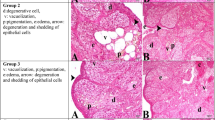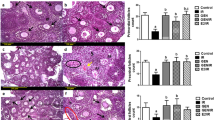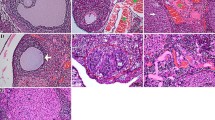Abstract
Background
Because radiotherapy is one of the causes of primary or secondary ovarian failure, protection of ovarian functions in the patients receiving total body or pelvic radiotherapy is of importance. In this study, we investigated the role of melatonin in the oxidative damage in both whole body and ovaries, which is caused by radiotherapy.
Materials and Methods
Eighteen female rats were divided into 3 groups, each of which consisted of 6 rats. First group was control group receiving no treatment, second group received total body radiotherapy (RT) by 2 × 360 cGy only and third group received radiotherapy plus melatonin. Malondialdehyde (MDA) levels in both blood and ovarian tissue were detected as the indicator of free radical (FR) damage. Levels of erythrocyte superoxide dismutase (SOD) and glutathion peroxidase (GPX) in blood were measured as the indicators of antioxidant level.
Results
Radiotherapy caused a significant increase in the levels of MDA in blood and ovarian tissue (p < 0.001). However, MDA levels decreased in the radiotherapy plus melatonin group (p < 0.05). SOD and GPX levels decreased insignificantly in the radiotherapy only group while they increased in the radiotherapy plus melatonin group significantly (p < 0.01 and p < 0.05, respectively).
Conclusion
Melatonin, in rats, reduced the level of MDA, which is elevated by radiotherapy and increased the levels of SOD and GPX, which are involved in the antioxidant system.
Zusammenfassung
Ziel
Da die Strahlentherapie eine der Ursachen der primären bzw. sekundären Ovarialinsuffienz ist, ist es wichtig, die ovariellen Funktionen der Patienten, die einer Beckenoder Gesamtkörperstrahlentherapie unterzogen werden, zu schützen. In dieser Studie untersuchten wir daher, ob Melatonin in der Lage ist, die oxidative Schädigung sowohl des Gesamtkörpers als auch der Eierstocke durch Strahlentherapie zu verringern.
Material und Methode
18 weibliche Ratten wurden in drei Gruppen unterteilt, von denen jede aus sechs Ratten bestand. Die erste Gruppe war die unbehandelte Kontrollgruppe, die zweite Gruppe empfing nur eine Strahlentherapie von 2mal 360 cGy, und die dritte Gruppe wurde strahlentherapiert und erhielt Melatonin (Radiotherapie + Melatonin). Der Gehalt an Malondialdehyd (MDA) im Blut und ovariellen Gewebe wurde als Indikator für die Schädigung durch freie Radikale bestimmt. Die Bestimmung von Superoxiddismutase (SOD) und von Glutathionperoxidase (GPX) diente als Indikator des antioxidativen Status.
Ergebnisse
Strahlentherapie verursachte eine bedeutende Zunahme des Gehalts von MDA im Blut und im ovariellen Gewebe (p < 0,001). In der Gruppe der Tiere, die Strahlentherapie und Melatonin erhielten, waren die MDA-Werte signifikant erniedrigt (p < 0,05), SOD und GPX waren in der Gruppe 2 (Radiotherapie) unverandert gegenüber der Kontrolle und erhöhten sich signifikant in der Gruppe 3 (Radiotherapie + Melatonin), (p < 0,01 für SOD und < 0,05 für GPX).
Schlußfolgerungen
Melatonin verringert bei Ratten den Gehalt an MDA nach Strahlentherapie und erhöht zudem den Gehalt an SOD und GPX, welche antioxidativ wirken.
Similar content being viewed by others
References
Barni S, Lissoni P, Cazzaniga M, et al. A randomized study of low-dose subcutaneous interleukin-2 plus melatonin versus supportive care alone in metastatic colorectal cancer patients progressing under 5-fluorouracil and Mates. Oncology 1995;52:243–5.
Beutler E. Glucose 6 phosphate dehydrogenase. In: Beutler E. A red cell metabolism. A manual of biochemical procedures, cd 2. New York: Grune & Stratton, 1975:66.
Blask DE, Hill SM. Melatonin and cancer: Basic and clinical aspects. In: Miles A, Philbrick DRS, Thompson C. Melatonin clinical perspectives. Oxford: Oxford Medical Publications, 1988:128–73.
Bomfort CK, Kunkler IH, Sheriff SB. Cervix, body of uterus, ovary, vagina, vulva, gestational trophoblastic tumours. In: Textbook of radiotherapy. Singapore: Livingstone 1993.
Cerutti PA, Trump BF. Inflammation and oxidative stress in carsinogenesis. Cancer Cells 1991;3:1–12.
Chevion M. A site-specific mechanism for free radical induced biological damage: The essential role of redox-active transition metals. Free Radic in Biol Med 1988;5:27–37.
Christie AK, James AN. Multiple antioxidants protect against protein and lipid oxidation in kidney tissue. Free Radic Biol Med 1996;20:165–73.
Fridovich I. The biology of oxygen radicals. Science 1978;201:875–80.
Fridrovich I. Biological effects of superoxide radical. Arch Biochem Biophys1985;247:1–11.
Green HJM, Meider C, De Vries EGE, et al. Red blood cell glutathione levels in lung cancer patients treated by radiation and continuously infused carboplatin. Anticancer Res 1996;16:1033–8.
Green Stock CL. Redox process in radiation biology and cancer. Radiat Res 1981;86:196–211.
Halliwell B. Reactive oxygen species and the central nervous system. J Neurochem 1992;59:1609–23.
Hardeland R, Reiter RJ, Poeggelar B. The significiance of the metabolism of the neurohormone melatonin: antioxidative protection and formation of bioactive substances. Neurosci Biobehav Rev 1993;17:347–57.
Lissoni P, Barni S, Tancini G, et al. Imrnunoendocrine therapy with lowdose subcutaneous interleukin-2 plus melatonin of locally advanced or metastatic endocrine tumours. Oncology 1995;52:163–6.
Nikishkin IA, Sukolunskii VN, Kovaleva OV, et al. Enzymes protecting the erythrocyte membrane during the combined exposure to an antioxidant complex and acute irradiation. Radiobiologie 1992:32:738–42.
Paglia D, Valentine WN. Studies on the quantitätive and qualitative characterisation of erythrocyte glutathione peroxidase. J Lab Clin Med 1967:70:158–69.
Pierrefiche G, Topall G, Cowboin G, et al. Antioxidant activity of melatonin in mice. Res Comm Chem Pathol Pharm 1993;80:211–23.
Poeggeler B, Reiter RJ, Tan DX, et al. Melatonin, hydroxyl radical-mediated oxidative damage and aging: A hypothesis. J Pineal Res 1993;14: 151–68.
Reiter RJ. Interactions of the pineal hormone melatonin with oxygencentered free radicals: a brief review. Brazil J Med Biol Res 1993;26: 1141–55.
Shank B. Techniques of magnetfield irradiation. Int J Radiat Oncol Biol Phys 1983;9:1925–31.
Subrameniam S, Shayama S, Shyamola DCS. Protective effect of vitamin E against CMF-induced damage in small intestinal brush border membrane of rats. Indian J Pharm 1994;26:213–7.
Sun Y, Oberley LW, Ying L. A simple method for clinical assay of superoxide dismutase. Clin Chem 1988;34:497–500.
Wasowicz W, Neve J, Peretz A. Optimized steps in fluorometric determination of thiobarbituric acid-reactive substances in serum: Importance of extraction pH and influence of simple preservation and storage. Clin Chem 1993;39:2522–6.
Withers HR. Biologic basis of radiation therapy. In: Perez CA, Brady LW. Principles and practice of radiation oncology, 2nd edn. PhiladelphiaNew York-London-Hagerstown: Lippincott, 1992:114–72.
Author information
Authors and Affiliations
Additional information
We would like to acknowledge the support of Private Oncology Centre.
Rights and permissions
About this article
Cite this article
Kaya, H., Delibas, N., Serteser, M. et al. The effect of melatonin on lipid peroxidation during radiotherapy in female rats. Strahlentherapie und Onkologie 175, 285–288 (1999). https://doi.org/10.1007/BF02743581
Received:
Accepted:
Issue Date:
DOI: https://doi.org/10.1007/BF02743581




